THE HISTORY OF ORWIN MANOR WESTMINSTER SECTION
By Sally Moon & Stephen Pategas
Watch Video: The Unquenchable Florida Land Boom – Walter W. Rose and Orwin Manor
Note: Please scroll to the bottom of the page for Emeritus and Honorary Status members
THE EARLIEST RECORDS
The history of the development of Orwin Manor dates to the mid-1800’s and includes the entrepreneur and statesman Walter W. Rose and more recently the Orwin Manor Association. The title abstracts passed along with the purchase of our homes provide information about the early history of Orwin Manor. The first document found pertaining to this part of Florida was signed by our fourteenth president, Franklin Pierce, who served from 1853 to 1857. Handwritten and difficult to read, it authorized the sale of land selected as “swamp and Oviglades” being situated in the “District of Lands” and subject to sale at Tampa, Florida. Signed the 13th day of November in 1856, the area involved Township 20, south of Range 39 east and Township 29 south of Range 39 east. A patent (land grant) dated April 25, 1874, and filed March 3, 1876, reveals that James M. Blitch of Orange County FL made full payment of $200.21 at the rate of $1.25 per acre to the general land office at Gainesville for 160.17 acres of land in Township 22, Range 29 east. This land grant was signed by President U. S. Grant, our eighteenth president who served from 1869 to 1877. Present day Orwin Manor lies within these 160 acres.
Apparently, James Blitch was an enterprising gentleman, because the very next year he sold all this land to James W. Wilkinson for $1,200 and realized a tidy profit of $1,000. In 1883 James and Mary Harper sold to Wilkinson an additional 40 acres in Township 22, Range 30 east at the rate of 75 cents per acre. When Wilkinson died in Charleston County, South Carolina in 1884 he left a will bequeathing all his estate to his wife, Sarah, but failed to name an executor. In 1892, Sarah Wilkinson (James’ wife) also of Charleston County, South Carolina, conveyed to Willis Wilkinson (presumably her son) all the property she possessed, both real and personal. In 1919 Willis Wilkinson, bachelor, conveyed to Huger W. Jervey of New York City all the lands he owned in Township 22, Range 29 East and Township 22, Range 30.
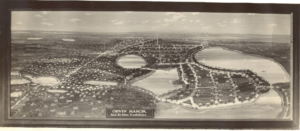
CENTRAL FLORIDA DEVELOPMENT ENTERS THE PICTURE
It was in June of 1924 that the unmarried Jervey sold all this property to Central Florida Development for $260,000 at a rate of $1,300 per acre. Central Florida Development had obtained their charter to sell real estate on February 23, 1924. For the first time we see mention of Walter W. Rose, President of Central Florida Development Company. Some eight years earlier, Walter Washington Rose had developed 48 acres on East Central Avenue, Orlando, and offered $25.00 in gold for the best name for his project. W. S. Branch, Sr., won the gold prize with “Rosearden”. In late 1921 Rose opened his “Rosemere” subdivision which generally encompassed the area south of New Hampshire Avenue to Princeton Street and West of Orange Avenue to Edgewater.
An office building for Walter Rose and Central Florida Development was erected in downtown Orlando at 49 N. Orange Avenue, just north of the former Angebilt Hotel and across from the former Beacham Theatre. It was restored in the mid-1990’s by Michael & Bonnie Stacks of John Glenn Jewelers. During the restoration they discovered a box of articles and photographs from the 20’s, 30’s and 40’s that related to Walter Rose’s career. The Orwin Manor Association has copies of some of these documents and old photographs.
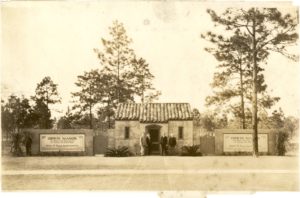
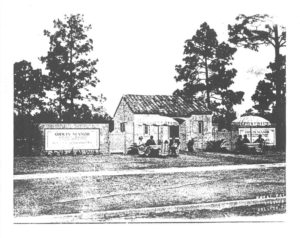
WHO WAS WALTER W. ROSE?
Walter Rose was an energetic, farsighted, innovative individual. He started his career as a Western Union operator after his school days in Athens, Georgia, where he was born on June 9, 1888. His father, B.O.W. Rose, was a Confederate veteran and an active member of Athens’ city government for 30 years.
Walter Rose learned telegraphy early and at age 16 was manager of the Greensboro, Georgia Western Union office. He served as manager of several other Western Union and postal telegraph offices in Georgia and in Orlando. For a time, he was a telegrapher for the Southern Railroad Company.
He came to Orlando in November of 1909 to straighten out a Western Union managership difficulty. After a few years he quit Western Union to take a sales position with a drug manufacturing firm, but in 1913 entered the real estate business here with twenty-five dollars.
His love of Florida, natural enthusiasm and the close study he made of land values and real estate laws soon brought success to the young Georgian who, in 1912, married Stella Smith, daughter of Mr. and Mrs. M. M. Smith of Winter Park. The Roses had one daughter, Harriet, who married Glen Spears, an Orlando haberdasher (hat salesman). In 1923 the Roses moved into a house at 226 E. Vanderbilt Street in Orlando just west of Orange Avenue and lived there until 1957.
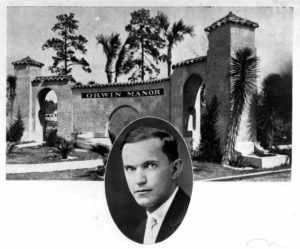
WALTER ROSE THE STATESMAN
Old acquaintances always addressed him as “Senator” as Walter Rose served Orange County and Florida with distinction and notable success as state senator from 1932-1949, totaling 16 years. He retired in 1949 after serving a term as senate president in 1943, when Senator Spessard L. Holland was wartime governor. Following his senate career, he was urged to run for governor of Florida, but felt he could best serve Florida as a private citizen. As a senator, he fathered the Florida real estate license law which created the Florida Real Estate Commission. He served as chairman from 1925 through 1932, when he was then elected to the senate.
Senator Rose was the originator and sponsor of the constitutional amendment eliminating ad valorem taxes on real estate for state purposes, considered one of his greatest accomplishments. He also helped shape legislation which converted the famed Florida Everglades into a great national park. Through one of his amendments, the homestead exemption law was made more practical.
All the finance and taxation bills offered for 16 years received critical attention from Senator Rose. He was considered the last word in legislative knowledge in these fields as well as real estate. When the Florida legislature was still in its free-booting era, Walter Rose was looked upon as a staunch advocate of decent, clean good government. He was a man of firm beliefs, sound principles and unflagging energy.
Walter Rose’s dealings with city, county and state government should be an example to everyone entering the land development business. He never sold or took to condemnation court a dime’s worth of his property that the government wanted to buy. He presented it to them free of charge on the theory that any progress would benefit him, so why should he have other taxpayers foot his bills.
Although Walter Rose died at the age of 70 on August 31, 1958 at 2615 Rose Isle Circle, his looks and carriage belied his age. He stood straight as a West Pointer, had piercingly handsome blue eyes, good looking features and was an immaculate dresser. He always wore a hat and was seldom without a necktie unless he was out among his horses on his 1,000-acre Fairvilla Ranch where the Rosemont subdivision is located. He was survived by his wife, daughter Harriet Spears, and one sister, Mrs. Walter B. Rose of Jacksonville, Florida.
ORWIN MANOR IS NAMED & A NEW LAND BOOM SUBDIVISION IS BORN
In 1924, during the Florida Land Boom days, Rose’s Central Florida Development Company launched its sixth development called Orwin Manor. The name “Orwin” is a combination of Orlando and Winter Park, and was suggested by Louise Morton. The Westminster section bounded by Clay Street to the west, Harmon Avenue to the north and the railroad tracks to the east was constructed first. It was closely followed by the Stratford section to the east of the railroad tracks. They were considered some of the finest subdivisions and the forerunner of other high-class subdivisions which Rose promoted such as the Beverly Shores section of Orwin Manor (opened in 1936) and Rose Isle where he built the home in which he died.
The first structures in Orwin Manor were the great stuccoed gates spanning three corners at the intersection of Orange Avenue, Clay Street and Wilkinson Street. The remaining structures were restored and designated an Orlando historic landmark in 1990 and Stella Rose and Harriet Spears were in attendance. Stella Rose died later that year. The similar gates flanking Orange Avenue just southeast of US17/92 were demolished at some point.
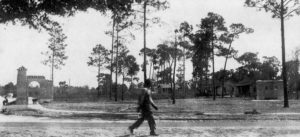
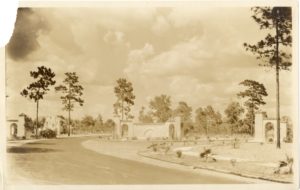
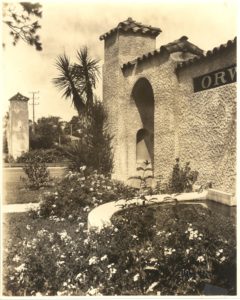
A sales office constructed in the Mediterranean revival style was soon constructed at 1701 North Orange Avenue along what was then the main and only two-lane road (then called Dixie Highway) between Orlando and Winter Park. The sales office was later demolished, and many neighborhood children used the land as an unofficial sports field.
ORWIN MANOR IS DEVELOPED
The first homes in Orwin Manor’s Westminster Section were built starting in 1925. A June 10, 1926 article in The Winter Park Herald stated “…in November of 1925 sales amounting to one-half million dollars were completed in twenty-six days. In this first (Westminster) section more than fifty home are occupied or under construction.” These homes were Mediterranean themed styles which virtually defined Florida’s great 1920’s land boom era along with a variety of styles including colonial revival, mission and bungalow.
Due to Walter Rose’s foresight, the streets of Orwin Manor, marketed as “The Great White Way” were lined with curbs, sidewalks, streetlights with underground wiring, oak trees and palms. When the land boom went bust, construction in Orwin Manor slowed and didn’t pick up again until the post WWII building boom when many vacant lots were cleared for new homes. Few of these used the Mediterranean themed styles from the previous decades. Walter Rose’s next subdivision was the Stratford Section of Orwin Manor on the east side of the railroad tracks.
In 1935, the 40 acres of Orwin Manor Westminster became a part of Orlando under a legislative bill. In August of 1936, a tax adjustment settlement was approved by the city as the subdivision had a federal lien against it. In exchange for the tax adjustment and discount of 28% against the taxes owed for 1934 and prior years, the City of Orlando received deeds to the small parkway at the south entrance, just where the grand gates stand along Orange Avenue. In October of 1937, Orlando, by ordinance, contracted its city limits to eliminate the 40 acres of Orwin Manor.
In the early 1950’s, the western portion of Orwin Manor was again annexed to Orlando and shortly after, the balance of the development’s residents from Berkshire Ave northward to Harmon were given a choice whether to go with Orlando or belong to Winter Park. By referendum with the vote held at the residence at 1492 Berkshire Avenue, Winter Park won, making Orwin Manor a true reflection of its name.
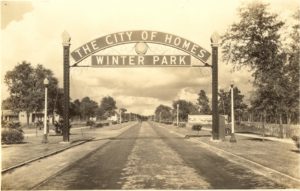
THE ORWIN MANOR ASSOCIATION IS FORMED
By the early 1980’s, the cast iron street lights along our Winter Park streets were failing and they were to be replaced with large gooseneck lights with overhead wiring. A concerted appeal to the Winter Park Commissioners brought about a compromise. By assuming a three-year assessment on our taxes (approximately $15.00 per house per year) we had our underground wiring replaced and new lamp heads installed. Unfortunately, the Orlando portion’s lamps were replaced with concrete poles and goosenecks.
In 1983 in response to growing development pressures along its boundaries the Orwin Manor Association (now the Orwin Manor Westminster Asociation) was founded as a voluntary neighborhood association. In 1990, the idea for a park in Orwin Manor was generated by a group of board members. The plot of land desired for a gathering place for the neighborhood was where the Orwin Manor sales office once stood at the southern corner of Orange and Berkshire Avenues. The land platted for four houses was still vacant and owned by Walter Rose’s widow Stella Rose.
The Orwin Manor Association formed a committee and together with the help of the City of Winter Park (which purchased the land for $160,000), residents of Orwin Manor and local businesses, the park became a reality. Money was raised through donations and the sale of inscribed sidewalk sections and engraved bricks. During construction some of the original street brick pavers used as walkways around the sales office were unearthed. The Park at Orwin Manor was dedicated in September of 1994 and in early 1996 the play equipment was installed by Winter Park and neighborhood volunteers. Many of the association’s events are held there where adults gather and socialize at the brick circle while children play in the playground and on the lawn. Today anyone can be part of the Orwin Manor legacy with the purchase of a personalized engraved brick added to the “circle of bricks” in the park.
On August 13, 2004 a swift Hurricane Charley ravaged Orwin Manor’s tree canopy with many homes damaged and a few destroyed. In the park numerous trees were toppled but miraculously they missed all the equipment. Within weeks subsequent Hurricanes Francis and Jeanne downed more trees in the neighborhood but neither matched the damage wreaked by Charley, the first major hurricane since Donna in 1960. In 2017 Hurricane Irma came through Central Florida near Lakeland but the damage was not nearly as severe as in 2004.
Orwin Manor, with its mix of longtime residents and young couples raising families is an interesting and colorful place to live. Along with the residents, it is the convenient location, variety of architecture with many historic homes, mature street tree canopy and our caring neighbors that make Orwin Manor such a lovely place to live.
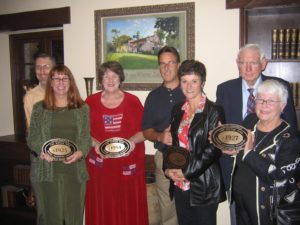
EMERITUS AND HONORARY STATUS
Orwin Manor Westminster Association Board Emeritus
Emeritus board members are individuals who have served on the Orwin Manor Westminster Association Board for ten years or longer. They have contributed to the success of the Board and have retired from their official duties.
Honored 2025
* Carol Card (15 years)
* Susan Ellis (10 years)
* Suzan Goldin (21 years)
* Alan Hatchitt (10 years)
* Sally Moon (12 years, In Memory of a Founding Board Member)
* Mary Ann Serkin (10 years)
Honorary Orwin Manor Westminsterite
Honorary Orwin Manor Westminsterites are individuals who may or may not be residents and have provided valuable assistance to the neighborhood.
Honored 2025
* Jeff Briggs (former resident and Winter Park Planning Director Emeritus)
* Joe Del Rocco (resident, website administration, neighborhood bronze sign restoration)
* Rosie Johnson (resident, longtime MYM Delivery Coordinator)
* Jean Siegfried (resident, longtime MYM Delivery Coordinator)
* Mary Soule (resident, longtime MYM Delivery Coordinator)
Updated January, 2025